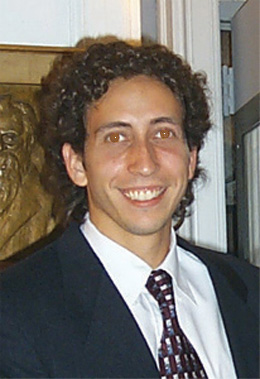 Jason Alicea; Photo by Lalena Lancaster |
The APS has honored two budding young physicists with the 2003 Apker Award for their undegraduate thesis work.
Jason Alicea of the University of Florida received the award for a PhD-granting institution for his thesis entitled, "Resistance of Multilayers with Long Length Scale Interfacial Roughness."
S. Charles Doret of Williams College received the award for a non-PhD-granting institution for his thesis entitled, "A Precise Measurement of the Stark Shift in the 6P1/2 -> 7S1/2 378 nm Transition in Atomic Thallium."
Magnetic multi-layers are mesoscopic structures composed of alternating ferromagnetic and paramagnetic layers. A theoretical understanding of the effects of interface roughness is essential for answering the question of what role the interface structure plays in determining the resistance and giant magnetoresistance of multilayers.
Researchers at the University of California at San Diego conducted a series of experiments to measure the magnetoresistance and interfacial roughness for a set of magnetic multilayers, and since the length scale of the roughness was much larger that the Fermi wavelength, it was surprising to see a substantial increase in the resistance with both the current parallel and perpendicular to the layers.
Similar experiments by a separate group at Michigan State University didn't see any change in the resistance with increased interfacial roughness.
Alicea's thesis centered on finding a theoretical explanation for these unusual experimental results by carrying out the numerical solution of the Boltzmann transport equation.
He first found that the long length scale interfacial roughness decreased resistance when the current was flowing perpendicular to the layers-the opposite of the UCSD experimental results. He then tried the short mean free path limit, and found that the resistance increased with interfacial roughness when the current flows either perpendicular or parallel to the layers, just as the UCSD researchers observed.
In his manuscript, Alicea carefully addressed the question of which parameter regime one needs in order to see a resistance increase, decrease or no change at all, and these well-defined calculations will help guide future work.
Alicea presented his work at the 2002 March Meeting and has submitted the final manuscript for publication in Physical Review B. He received his B.S. in physics in December 2001 and is currently pursuing graduate studies in condensed matter theory at the University of California, Santa Barbara, with an NSF Graduate Research Fellowship.
 |
He constructed, tested, redesigned and optimized important pieces of the optical system, the atomic beam system, the high-voltage system, and the data acquisition system. His significant improvements to the experimental apparatus enabled him to collect and analyze an enormous amount of high-precision Stark shift data.
Much of the experimental challenge for Doret was to identify and eliminate systematic errors. He performed extensive computer simulations, and completed many paper-and-pencil estimates of potential effects; proposed various experimental "checks" and some redesign of the data collection method and, based on this, has completed a thorough experimental exploration of potential errors.
His result was a measurement of the Stark shift with 0.4% accuracy, and experimental precision now far exceeds the precision of calculated thallium wave functions, presenting a challenge for future theoretical improvement.
Doret presented his results at the May 2002 meeting of the APS Division of Atomic, Molecular and Optical Physics in Williamsburg, VA, and has submitted the final manuscript to Physical Review A for publication. He received B.S. degrees in physics and mathematics in May 2002 and is currently pursuing graduate studies in physics at Harvard University.
©1995 - 2024, AMERICAN PHYSICAL SOCIETY
APS encourages the redistribution of the materials included in this newspaper provided that attribution to the source is noted and the materials are not truncated or changed.
Associate Editor: Jennifer Ouellette
December 2002 (Volume 11, Number 12)
Articles in this Issue

